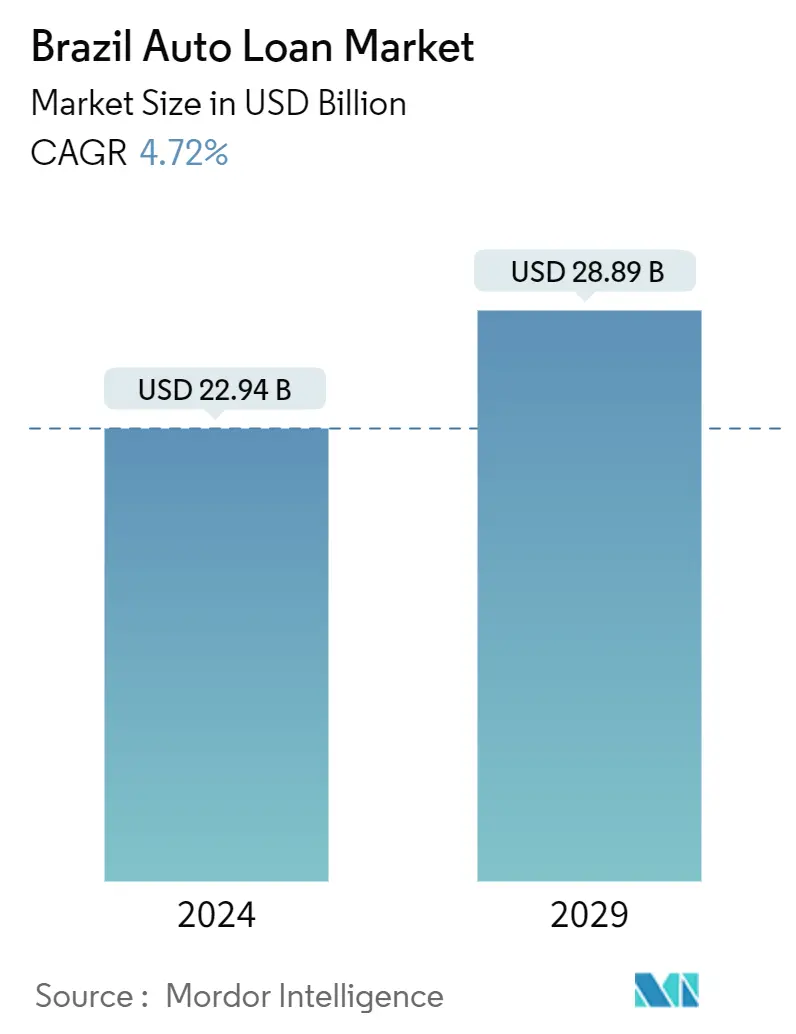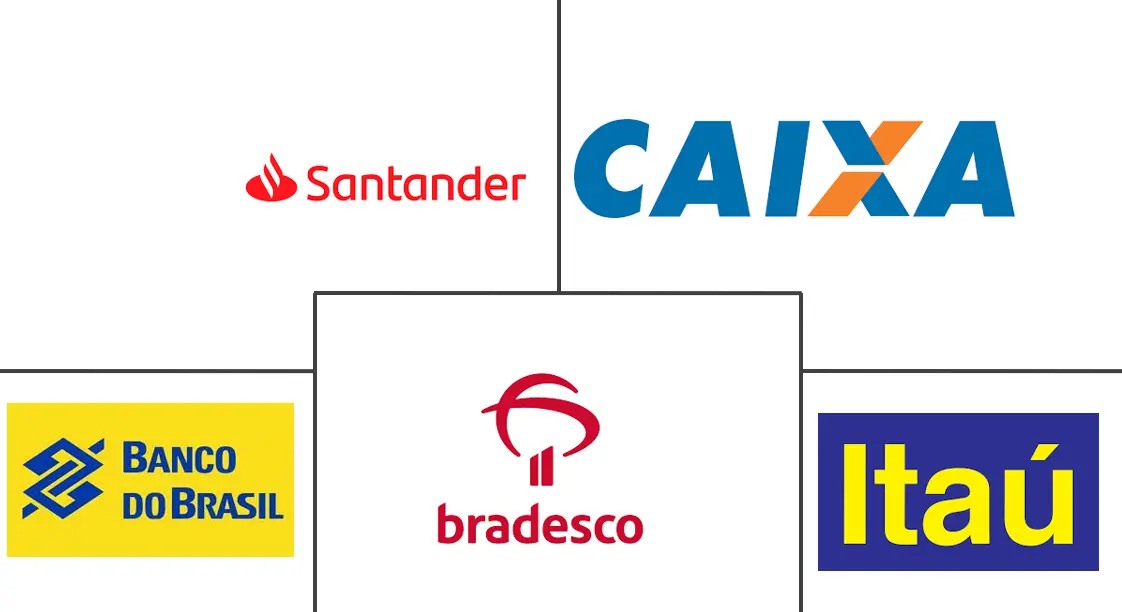
| Study Period | 2020-2029 |
| Base Year For Estimation | 2023 |
| Forecast Data Period | 2024 - 2029 |
| Market Size (2024) | USD 22.94 Billion |
| Market Size (2029) | USD 28.89 Billion |
| CAGR (2024 - 2029) | 4.72 % |
| Market Concentration | Medium |
Major Players
*Disclaimer: Major Players sorted in no particular order |
Brazil Auto Loan Market Analysis
The Brazil Auto Loan Market size is estimated at USD 22.94 billion in 2024, and is expected to reach USD 28.89 billion by 2029, growing at a CAGR of 4.72% during the forecast period (2024-2029).
The Central Bank of Brazil (Banco Central do Brasil) plays a central role in regulating financial institutions, including those involved in auto financing. It establishes policies and regulations to maintain financial stability. Brazil has consumer protection laws in place to safeguard the rights of individuals obtaining auto financing. These laws cover aspects such as transparency in lending practices, fair interest rates and lending practices, fair interest rates, and disclosure of terms and conditions. Auto Loan institutions are often required to adhere to risk management standards to mitigate financial risks associated with lending activities.
Providing financing decisions instantly and reducing auto loan paperwork proved beneficial for both customers and the auto dealers/bank, improving customer experience and innovating the auto loan process. The new digital platform also allows customers to implement automated, risk-based pricing. When the bank introduced the mobile auto loans app, Brazil’s GDP was down eight percent. The launch of the app increased revenue, a rise in customer satisfaction, and a surge in new loans for the bank.
The overall economic conditions in Brazil, including factors like GDP growth, inflation rates, and unemployment, play a significant role in influencing consumer confidence and their ability to take on auto loans. Central bank policies and prevailing interest rates impact the cost of borrowing. Lower interest rates often stimulate demand for auto loans, making financing more attractive for consumers.
Brazil Auto Loan Industry Segmentation
An auto loan is a segment of the loan category offered by banks and financial service providers to automobile buyers over a given period with an agreed interest rate and installment amount. Mostly, the loan is taken for two segments of automobiles, which consist of passenger and commercial vehicles.
The study gives a brief description of the Brazilian auto loan market and includes details on interest rates, type of loans offered, and auto loan products & services. Brazil's auto loan market is segmented by product, ownership, provider type, and tenure. By product, the market is segmented into passenger vehicles and commercial vehicles. By ownership, the market is segmented by new vehicles and used vehicles. By provider type, the market is segmented by banks, non-banking financial companies, original equipment manufacturers, credit unions, and other provider types (fintech companies). By tenure, the market is segmented into less than three years, 3-5 years, and more than 5 years.
The report offers market size and forecasts for the Brazil auto loan market in value (USD) for all the above segments.
| Passenger Vehicle |
| Commercial Vehicle |
| New Vehicles |
| Used Vehicles |
| Banks |
| NBFCs (Non Banking Financials Companies) |
| Credit Unions |
| Other Provider Types (Fintech Companies) |
| Less than Three Years |
| 3-5 Years |
| More Than 5 Years |
Brazil Auto Loan Market Size Summary
The Brazil auto loan market is poised for steady growth over the forecast period, driven by regulatory support and technological advancements. The Central Bank of Brazil plays a crucial role in maintaining financial stability through its regulations on auto financing institutions, ensuring transparency and fairness in lending practices. The introduction of digital platforms and mobile apps has significantly enhanced the customer experience by streamlining the loan process and offering automated, risk-based pricing. These innovations have not only improved customer satisfaction but also boosted revenue and loan uptake for financial institutions, even during challenging economic conditions. The market is influenced by broader economic factors such as GDP growth, inflation, and unemployment, which affect consumer confidence and borrowing costs. Lower interest rates tend to stimulate demand for auto loans, making them more appealing to consumers.
The market is characterized by a competitive landscape with numerous players, including major banks like Banco do Brasil, Caixa Economica Federal, Banco Bradesco, Santander, and Itau Unibanco. The growing interest in used cars, driven by their affordability and the rapid depreciation of new vehicles, has made them a popular choice among budget-conscious consumers. The availability of financing options and the rise of online platforms have further facilitated access to used cars. Additionally, the increasing registration of electric vehicles is prompting lenders to develop specialized financing programs to encourage their adoption. Government incentives and the development of charging infrastructure are also shaping the auto loan market, making financing for electric vehicles more attractive. Strategic partnerships, such as those between BYD and Santander, and JPMorgan Chase's investment in C6, highlight the ongoing efforts to enhance digital auto finance solutions in Brazil.
Brazil Auto Loan Market Size - Table of Contents
1. MARKET DYNAMICS AND INSIGHTS
- 1.1 Market Overview
-
1.2 Market Drivers
- 1.2.1 Quick Processing of Loan through Digital Banking
-
1.3 Market Restraints
- 1.3.1 Rising Interest Rates Affecting New Auto Buyers Demand for Loan
-
1.4 Market Opportunities
- 1.4.1 Emerging Market of Electric Vehicles Expanding the Auto Loan Market
-
1.5 Industry Attractiveness - Porter's Five Forces Analysis
- 1.5.1 Bargaining Power of Suppliers
- 1.5.2 Bargaining Power of Buyers
- 1.5.3 Threat of New Entrants
- 1.5.4 Threat of Substitutes
- 1.5.5 Intensity of Competitive Rivalry
- 1.6 Insights on Consumer Behavior Analysis
- 1.7 Insights on Regulatory Trends Shaping the Market
- 1.8 Insights on impact of technology in the Market
- 1.9 Impact of COVID-19 on the Market
2. MARKET SEGMENTATION
-
2.1 By Vehicle Type
- 2.1.1 Passenger Vehicle
- 2.1.2 Commercial Vehicle
-
2.2 By Ownership
- 2.2.1 New Vehicles
- 2.2.2 Used Vehicles
-
2.3 By Provider Type
- 2.3.1 Banks
- 2.3.2 NBFCs (Non Banking Financials Companies)
- 2.3.3 Credit Unions
- 2.3.4 Other Provider Types (Fintech Companies)
-
2.4 By Tenure
- 2.4.1 Less than Three Years
- 2.4.2 3-5 Years
- 2.4.3 More Than 5 Years
Brazil Auto Loan Market Research FAQs
How big is the Brazil Auto Loan Market?
The Brazil Auto Loan Market size is expected to reach USD 24.02 billion in 2025 and grow at a CAGR of 4.72% to reach USD 30.25 billion by 2030.
What is the current Brazil Auto Loan Market size?
In 2025, the Brazil Auto Loan Market size is expected to reach USD 24.02 billion.


